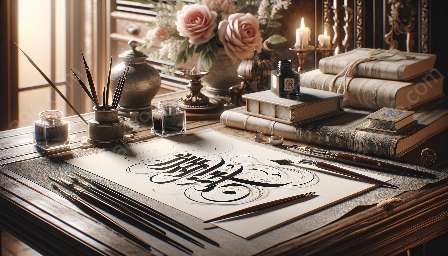Roman calligraphy, also known as Latin calligraphy, is an ancient art form that involves writing and decorative ornamentation using the Latin alphabet. Roman calligraphy has a rich history and has been an important form of artistic expression throughout the ages.
Decorative ornaments and motifs play a significant role in Roman calligraphy, adding beauty and complexity to the written word. Artists and calligraphers use various techniques to create these decorative elements, contributing to the overall aesthetic appeal of the script.
The History of Roman Calligraphy
Roman calligraphy has its roots in ancient Rome, where it was used for inscriptions, manuscripts, and official documents. The Romans developed an intricate and refined writing style that became the basis for modern Western calligraphy.
Throughout history, Roman calligraphy has evolved and adapted to various artistic movements and cultural influences. It has been used in religious texts, illuminated manuscripts, and architectural ornamentation, leaving a lasting imprint on the visual arts.
Techniques for Creating Decorative Ornaments and Motifs
Creating decorative ornaments and motifs in Roman calligraphy requires precision, skill, and an understanding of the historical and cultural context. Calligraphers use a variety of techniques to embellish their work, including the following:
- Flourishing: Flourishing involves adding intricate swirls, loops, and embellishments to the letters to create a sense of movement and elegance. It can range from simple embellishments to elaborate designs that fill the page with life and energy.
- Border Patterns: Calligraphers often incorporate border patterns, such as vines, geometric shapes, and floral motifs, to enhance the visual appeal of a piece of writing. These borders can help frame the text and draw the viewer's eye to the central message.
- Embellished Initials: Artists often embellish the first letter of a word or paragraph, known as the initial, with ornate designs and decorative elements. This practice adds visual interest and serves as a focal point for the text.
- Historical Scripts: Some calligraphers study and replicate historical scripts, such as Carolingian or Uncial, incorporating the unique ornamental features of these scripts into their work.
Materials and Tools
Calligraphers use a variety of materials and tools to create decorative ornaments and motifs in Roman calligraphy. These may include:
- Pen Nibs: Different types of pen nibs, such as pointed nibs and broad-edged nibs, are used to achieve varying line thickness and expressive strokes.
- Ink: High-quality ink is essential for creating vibrant and long-lasting decorative elements. Calligraphers may use traditional ink made from natural materials or modern alternatives.
- Parchment and Paper: The choice of parchment or paper can significantly impact the appearance of the decorative elements. Fine-quality materials allow for precise and detailed work.
- Gold Leaf and Metallic Inks: Some calligraphers use gold leaf and metallic inks to add a touch of luxury and opulence to their decorative motifs.
Applications of Roman Calligraphy
Roman calligraphy and its decorative ornaments and motifs have found diverse applications in art, design, and cultural expression. Some of the notable applications include:
- Typography and Graphic Design: Roman calligraphy continues to influence typography and graphic design, with its ornamental motifs and elegant letterforms providing inspiration for contemporary designers.
- Wedding Invitations and Stationery: Calligraphers often create bespoke wedding invitations and stationery, incorporating decorative elements and motifs to add a personal and artistic touch to these special occasions.
- Artistic Commissions: Artists and calligraphers receive commissions for creating custom pieces, such as poems, quotes, and personalized gifts, where decorative ornaments and motifs enhance the visual impact of the text.
- Historical Reproduction and Preservation: Scholars and enthusiasts of historical scripts use Roman calligraphy to reproduce and preserve ancient texts and documents, ensuring that the art of decorative ornamentation continues to be celebrated and studied.
Overall, the creation of decorative ornaments and motifs in Roman calligraphy represents a harmonious blend of artistic expression, cultural heritage, and technical skill. It continues to inspire and captivate audiences around the world, showcasing the enduring beauty and versatility of this ancient art form.

